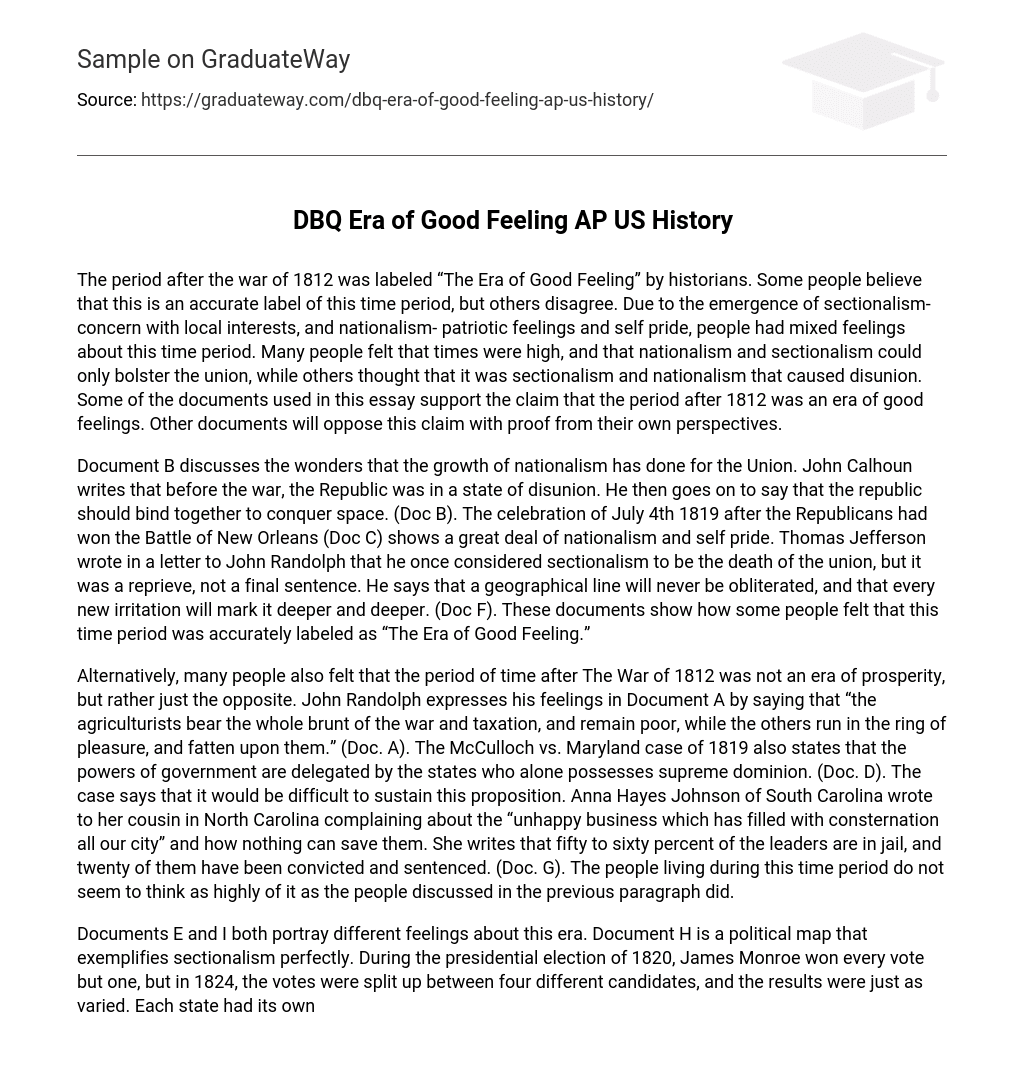The period after the war of 1812 was labeled “The Era of Good Feeling” by historians. Some people believe that this is an accurate label of this time period, but others disagree. Due to the emergence of sectionalism- concern with local interests, and nationalism- patriotic feelings and self pride, people had mixed feelings about this time period. Many people felt that times were high, and that nationalism and sectionalism could only bolster the union, while others thought that it was sectionalism and nationalism that caused disunion. Some of the documents used in this essay support the claim that the period after 1812 was an era of good feelings. Other documents will oppose this claim with proof from their own perspectives.
Document B discusses the wonders that the growth of nationalism has done for the Union. John Calhoun writes that before the war, the Republic was in a state of disunion. He then goes on to say that the republic should bind together to conquer space. (Doc B). The celebration of July 4th 1819 after the Republicans had won the Battle of New Orleans (Doc C) shows a great deal of nationalism and self pride. Thomas Jefferson wrote in a letter to John Randolph that he once considered sectionalism to be the death of the union, but it was a reprieve, not a final sentence. He says that a geographical line will never be obliterated, and that every new irritation will mark it deeper and deeper. (Doc F). These documents show how some people felt that this time period was accurately labeled as “The Era of Good Feeling.”
Alternatively, many people also felt that the period of time after The War of 1812 was not an era of prosperity, but rather just the opposite. John Randolph expresses his feelings in Document A by saying that “the agriculturists bear the whole brunt of the war and taxation, and remain poor, while the others run in the ring of pleasure, and fatten upon them.” (Doc. A). The McCulloch vs. Maryland case of 1819 also states that the powers of government are delegated by the states who alone possesses supreme dominion. (Doc. D). The case says that it would be difficult to sustain this proposition. Anna Hayes Johnson of South Carolina wrote to her cousin in North Carolina complaining about the “unhappy business which has filled with consternation all our city” and how nothing can save them. She writes that fifty to sixty percent of the leaders are in jail, and twenty of them have been convicted and sentenced. (Doc. G). The people living during this time period do not seem to think as highly of it as the people discussed in the previous paragraph did.
Documents E and I both portray different feelings about this era. Document H is a political map that exemplifies sectionalism perfectly. During the presidential election of 1820, James Monroe won every vote but one, but in 1824, the votes were split up between four different candidates, and the results were just as varied. Each state had its own mind and voted for who they felt was right, and not just as one union. Document E is a density map that shows how populated each square mile of land was in 1820. Much of the land had less than two inhabitants per square mile, and the people living there felt that they shouldn’t be taxed the same as somewhere where there were ninety or more inhabitants like in the northeast. This is a prime example of people who did not think this was “The Era of Good Feeling.”
“The Era of Good Feeling” is a label given to the time period after the war of 1812 by historians. Documents used in this essay both prove and disprove this label. Some people thought that now that the union was strong, they could build roads and better transportation systems to strengthen it even more. Other people felt that they were being taxed unfairly, and thought that this was the farthest things from an era of good feeling. No one side is right, because everyone is entitled to his own opinion, but the majority of the documents’ authors felt that “The Era of Good Feeling” was an accurate label for this time period.





